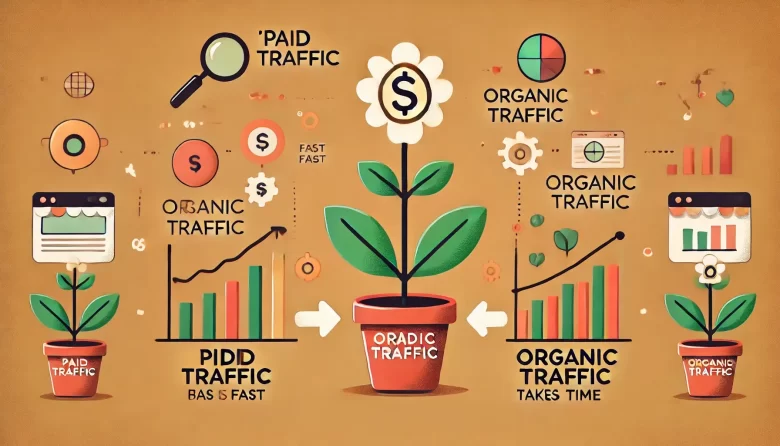When it comes to digital marketing, one of the main objectives is to increase the number of visitors to a website. After all, more visitors mean more sales opportunities and, consequently, business growth. There are two main ways to attract people to your website: paid traffic and organic traffic. While both are effective, they work differently and yield distinct results.
In this article, we’ll explore the differences between these two types of traffic in a clear and straightforward way. If you’re a business owner starting to delve into digital marketing, keep reading to understand how each can help grow your business.
What is Paid Traffic?
Paid traffic occurs when you invest money to make your website appear to a specific target audience. This can be achieved through ads on platforms like Google, Facebook, Instagram, or other networks. Each time someone clicks on your ad and visits your website, it’s considered paid traffic.
In short, you’re paying for your content to be seen, whether through ad clicks (like Google Ads) or sponsored post impressions (like Facebook Ads). These ads appear prominently, whether in search results or on social media, capturing the audience’s attention.
Practical Examples
- When you search for something on Google and see the first results labeled “Ad,” these are examples of paid traffic.
- On Instagram, when you see a post marked “Sponsored,” it’s an ad that is part of a paid traffic strategy.
What is Organic Traffic?
Organic traffic, on the other hand, happens when people find your website “naturally,” without you having to pay directly for it. This occurs when your site’s content appears among unpaid search engine results, like Google, or when your followers share your posts on social media.
To generate organic traffic, you need to focus on search engine optimization (SEO), which involves creating relevant content, using appropriate keywords, and implementing other strategies to help your site rank high in search engine results.
Practical Examples
- When you search on Google for “best dentists in Mauá” and find a site among the top results without the “Ad” label, that’s an example of organic traffic.
- On Facebook, if someone shares a post from your business and new customers find you without any payment on your part, that’s organic traffic.
Paid Traffic vs. Organic Traffic: Which Should You Choose?
Now that we understand what paid and organic traffic are, let’s explore their key differences and how they can impact your business.
Time to Achieve Results
- Paid Traffic: If you need quick results, paid traffic is ideal. Once your ads are set up, they immediately start reaching your target audience, and clicks can begin almost instantly.
- Organic Traffic: Organic traffic takes time. You need to build your online presence consistently, creating quality content and optimizing your site. It typically takes months for a website to gain enough relevance to appear in top search results.
Cost
- Paid Traffic: Requires constant financial investment. Each click or impression on your ads comes at a cost. Depending on competition and target audience, costs can vary significantly. The advantage is that you have control over your budget and can adjust it based on results.
- Organic Traffic: Doesn’t involve direct payment for each visit. However, there are indirect costs, such as hiring professionals to optimize your site’s SEO or dedicating time and effort to creating quality content.
Long-Term Sustainability
- Organic Traffic: More sustainable in the long run. Once your site is well-ranked in search engines and you keep producing relevant content, traffic tends to remain steady without ongoing financial investment.
- Paid Traffic: Generates visitors only as long as you continue paying for ads. When you stop investing, visitor numbers drop significantly.
Control Over Target Audience
- Paid Traffic: Offers complete control over who sees your ads. You can define specifics like age, location, interests, and even behaviors of the audience you want to reach. This makes paid traffic ideal for highly targeted campaigns.
- Organic Traffic: Harder to control. Although you can use SEO to attract the right audience, there are no guarantees that your content will reach the exact profile of people you aim to target.
Paid Traffic Strategies
To make the most of paid traffic, consider these strategies:
- Precise Targeting: Use the tools available on ad platforms to define exactly who will see your ads. The more specific you are, the higher your chances of success.
- A/B Testing: Test different versions of your ads to identify which ones are more effective. Small changes in text, images, or target audience can make a big difference.
- Metric Tracking: Monitor performance metrics, such as CPC (cost per click) and CTR (click-through rate). This will help you adjust your strategy in real-time.
Organic Traffic Strategies
To generate organic traffic, implement these key strategies:
- Quality SEO: Ensure your site is optimized for search engines by using the right keywords, having a fast loading speed, and creating relevant content.
- Consistent Content Creation: Develop informative content that addresses your customers’ questions to maintain their interest in the long term.
- Backlinks: Get high-quality websites to link to yours, increasing your content’s relevance and authority in search engines.
When to Use Each?
Ideally, you should use paid and organic traffic in a complementary way. If you’re just starting and need quick results, paid traffic is an excellent way to accelerate the process. However, building a solid foundation with organic traffic ensures that your site continues to attract visitors without recurring costs in the long term.
Conclusion
Now that you know the main differences between paid and organic traffic, you can decide which approach makes more sense for your business. The ideal strategy is to balance both, leveraging the speed of paid traffic and the sustainability of organic traffic. Remember, digital marketing is not a one-size-fits-all solution, and adapting your strategy to your audience’s needs and budget is essential for long-term success.
FAQ: Frequently Asked Questions
- What is the main difference between paid and organic traffic?
Paid traffic involves investment in ads, while organic traffic comes naturally without direct payment. - How much does paid traffic cost?
The cost of paid traffic varies depending on the platform and competition in your market niche, but you can control your budget. - How long does it take to see results with organic traffic?
Organic traffic results can take months, as they depend on factors like SEO and content production. - Is organic traffic truly free?
While you don’t pay directly for clicks, organic traffic requires investments in time and possibly SEO and content creation professionals. - Should I use only paid or organic traffic?
The ideal approach is to combine both strategies, using paid traffic for quick results and organic traffic for long-term sustainability. - How can I improve my organic traffic?
Invest in SEO, produce relevant content, and acquire backlinks from reputable sites. - Does paid traffic work for all types of businesses?
Yes, paid traffic can be tailored to different business types, as long as the targeting and strategy are well-planned.




